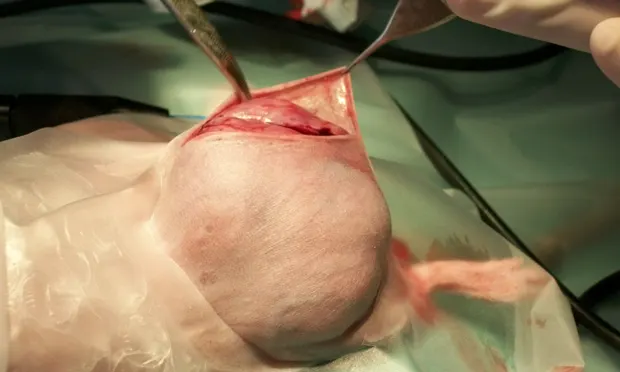Mammary Tumors in Rats

Tumors, particularly mammary tumors, are commonly seen in rats.1 Mammary tumors are usually diagnosed in rats older than 1 year of age, with up to 90% occurring in intact females and up to 16% in males.2 Data may vary, but approximately 80% of mammary tumors are benign fibroadenomas, which can recur at the original site or at additional sites after removal.3 Approximately 20% to 25% are adenocarcinomas,3 which can develop without a prior adenoma stage4 and are malignant, having the potential for local invasion but a tendency for relatively slow metastasis.
Related Article: Environmental Enrichment for Small Mammals
Pathophysiology
In rats, predisposing factors for development of mammary tumors include genetic strain, diet, environment, physiologic status, and hormonal status, particularly the presence of prolactin.5 Prolactin is secreted during estrus, which occurs every 3 to 5 days in rats and can stimulate very rapid tumor growth. Secretion of prolactin also increases in both male and female rats as they age.4 In addition, mammary tumors can occur secondary to pituitary adenomas which secrete prolactin and promote chronic stress and obesity.3
Rats fed ad libitum have been shown to have a higher incidence of pancreatic, mammary, and pituitary tumors than do rats fed restricted amounts of the same diet.6,7 The presence of hormonally-derived tumors have likewise been shown to be affected by ad libitum feeding,6 whereby excessive caloric intake can decrease tumor latency and increase tumor growth.7
Related Article: Exotic Pet Ownership: Responsible or Not?
Clinical Presentation
Because mammary tissue is so extensive, tumors can develop anywhere from the cervical region to the base of the tail.2,8 The tumors grow rapidly, becoming very large within weeks. Rats appear to tolerate the tumors, initially eating and acting normally despite the presence of a mass. Thus, owners often do not present their rat until the tumor has grown very large. If the patient is stable, owners should be advised to schedule surgery immediately (see Treatment).
Complications of large mammary tumors include difficulty ambulating, difficulty grooming, and ulceration of affected tissue, with potential risk for blood loss anemia secondary to ulceration of the mass. Weight loss despite good appetite may occur because the nutrients being consumed by the patient are supporting growth of the mass. Necrosis and secondary infection can also be factors, possibly leading to septicemia, organ failure, and death.3 As tumors grow larger, surgical removal becomes more risky because of the loss of blood and subsequent shock (from rapid changes in fluid balance) associated with tumor removal.
The differential diagnosis for mammary tumors in rats includes abscesses, mastitis, and other forms of neoplasia, including lymphoma. Although samples can be obtained for fine-needle aspiration and cytology, the results can be misleading if the tumor has necrotic areas that contain inflammatory cells.4
Related Article: Zoonoses of Small Mammals
Treatment
Surgical excision, preferably early in the course of tumor development, is the treatment of choice (see Keys to Successful Removal of Mammary Tumors in Rats). Mammary tumors are usually well demarcated and associated with a large vessel2; often they are ovoid or discoid and firm. Benign fibroadenomas are not usually attached to underlying tissue, making them relatively easy to remove by blunt dissection. Adenocarcinomas are generally more adherent to SC tissue.
With careful dissection, the skin over benign tumors can be preserved, facilitating closure. With malignant tumors, however, skin should be resected if possible to help minimize local invasion of tumor cells into overlying skin.9 For large tumors, ligating arteries before veins may allow blood to flow back into the patient’s circulation prior to excision.9 Careful attention to pain management, including preoperative analgesia, local blocks along the incision lines, and postoperative multimodal analgesia, can limit self-mutilation of surgical areas and help facilitate the patient’s return to normal diet and activity.

Case 1.
This white rat had a large mammary mass, the most common tumor type found in rats.
Prevention
To minimize tumor recurrence, ovariectomy or ovariohysterectomy is recommended in addition to removal of the mass.10 Early ovariohysterectomy or ovariectomy also may lessen the likelihood of mammary tumors by arresting development of mammary tissue.4 To minimize surgical time and trauma, it may be wise to remove large masses and wait 3 to 4 weeks before performing an ovariohysterectomy.
Clinical experience demonstrates that implementing dietary restrictions, easing environmental stress, and providing exercise and environmental enrichment should also help lessen the likelihood of tumor development. Tamoxifen, used in the treatment of human breast cancer, is unlikely to be of value in rats, primarily because of its effects against estrogen rather than prolactin as well as its hepatocarcinogenic properties.2 Gonadotropin-releasing hormone agonists (eg, deslorelin acetate, leuprolide acetate) may be useful in rats when ovariectomy is deemed to be too risky.4
Teresa Bradley Bays, DVM, CVA, DABVP (ECM) is an ABVP Diplomate in Exotic Companion Mammals, and a Certified Veterinary Acupuncturist. Owner of Belton Animal Clinic and Exotic Care Center in Belton, Missouri, she has authored numerous articles in exotic animal medicine, several chapters for Veterinary Clinics of North America/Exotic Animal Practice, and is an international speaker. She is senior editor/coauthor of Exotic Pet Behavior – Birds, Reptiles and Small Mammals, and the behavior chapter in Ferrets, Rabbits and Rodents. She created the Pajamas for Foster Kids Program for MFCAA and co-leads KC-CAN educating people about the link between animal abuse and domestic violence.